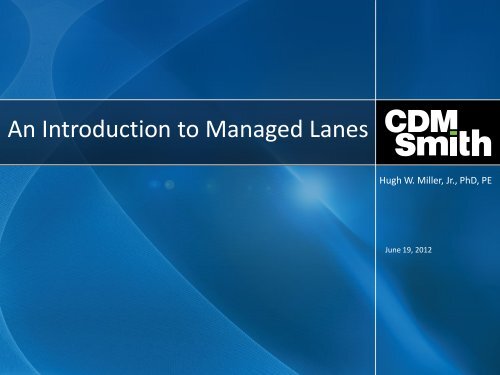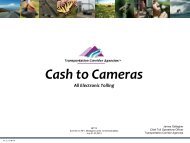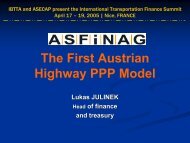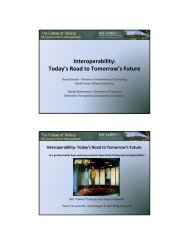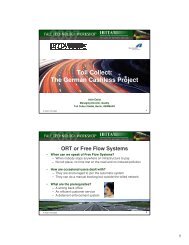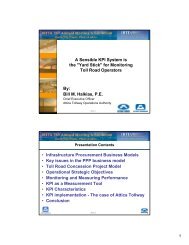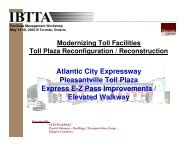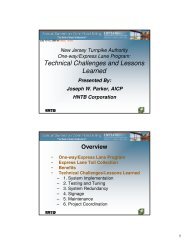Hugh Miller
Hugh Miller
Hugh Miller
You also want an ePaper? Increase the reach of your titles
YUMPU automatically turns print PDFs into web optimized ePapers that Google loves.
An Introduction to Managed Lanes<br />
<strong>Hugh</strong> W. <strong>Miller</strong>, Jr., PhD, PE<br />
June 19, 2012
Purpose<br />
• Managed Lanes 101<br />
• Tolled Managed Lane Projects<br />
–95 Express in Miami-Dade<br />
• Conclusions<br />
“An Introduction to Managed Lanes” by <strong>Hugh</strong> <strong>Miller</strong>
Managed Lanes<br />
• Managed lanes are typically an “expressway<br />
within a expressway,” with “special-purpose”<br />
lanes separated from “general-purpose” lanes<br />
• Operations in the special purpose lanes are<br />
actively managed in response to changing<br />
conditions<br />
• Managed with a combination of tools,<br />
including:<br />
– Pricing,<br />
– Vehicle eligibility, and<br />
– Access control<br />
“An Introduction to Managed Lanes” by <strong>Hugh</strong> <strong>Miller</strong>
Managed Lanes<br />
Source:<br />
“Managed Lanes:<br />
A Primer,” FHWA,<br />
US Department<br />
of Transportation,<br />
2005<br />
“An Introduction to Managed Lanes” by <strong>Hugh</strong> <strong>Miller</strong>
Managed Lanes<br />
• Pricing<br />
– Traditional toll lanes<br />
– Value-priced lanes (higher in peak – lower in<br />
off-peak periods)<br />
• Vehicle Eligibility<br />
– Vehicle occupancy (HOV)<br />
– Vehicle classification (trucks)<br />
• Access Control<br />
– Express lanes – limited entry/exit points<br />
– Reversible lanes<br />
“An Introduction to Managed Lanes” by <strong>Hugh</strong> <strong>Miller</strong>
Managed Lanes<br />
• Increased complexity with more active management and<br />
combinations of strategies<br />
– HOT lanes<br />
– Busways<br />
– Exclusive truck facilities<br />
• Active management is distinguishing feature<br />
• Might include actions to maintain performance, such as<br />
– Raising toll rates to maintain speed<br />
– Raising occupancy rate to maintain operating speeds<br />
– Closing a ramp to reduce volume in a critical segment<br />
• Create new, viable travel options in congested corridors<br />
• Circumstances vary – one size (solution) does not fit all<br />
“An Introduction to Managed Lanes” by <strong>Hugh</strong> <strong>Miller</strong>
Managed Lanes<br />
• Pricing<br />
– Basic idea is to vary the price<br />
• Increasing toll rates will control and limit demand<br />
• High toll rate in peaks and low toll rates in off-peaks<br />
• Pricing to maintain high speeds in managed lanes<br />
• Pricing to encourage ridesharing/transit and peak<br />
spreading<br />
– People at all income levels use managed lanes<br />
– Electronic toll collection is important<br />
• Change toll in small increments over a short time<br />
• Transponders are required on most tolled managed<br />
lanes<br />
“An Introduction to Managed Lanes” by <strong>Hugh</strong> <strong>Miller</strong>
Managed Lanes<br />
• Pricing (continued)<br />
– Different pricing policies reflect agency goals<br />
• Traffic optimizing – highest throughput or<br />
minimal delay in the corridor<br />
• Revenue optimizing – most revenue for financing<br />
purposes<br />
– Implementation terms<br />
• “Variable pricing” (preset schedule)<br />
• “Dynamic pricing” (changes on the fly in<br />
response to conditions)<br />
– Enforcement<br />
“An Introduction to Managed Lanes” by <strong>Hugh</strong> <strong>Miller</strong>
Managed Lanes<br />
5%<br />
15%<br />
SOV<br />
• Vehicle Eligibility<br />
– Vehicle occupancy<br />
80%<br />
• High occupancy vehicles (HOV)<br />
• HOV conversion to HOT lanes – SUVs “buy in”<br />
• HOV2+ vs. HOV3+<br />
– Vehicle classification<br />
• Hybrid vehicles<br />
• Trucks have significant effect on operations<br />
• Truck restriction helps managed lane operation<br />
and hampers general-purpose lane operations<br />
– Enforcement<br />
HOV 2<br />
HOV 3+<br />
Typical percent of vehicles<br />
“An Introduction to Managed Lanes” by <strong>Hugh</strong> <strong>Miller</strong>
Managed Lanes<br />
• Physical<br />
– Commonly managed lanes are located in the<br />
median – “expressway within an expressway”<br />
– Number of lanes in each roadway<br />
• Single vs. multiple managed lanes<br />
• Don’t reduce the number of general-purpose lanes<br />
• Reversible lanes<br />
• Type of separation (barrier, pylons, movable<br />
barrier or striping)<br />
– Instrumentation and control<br />
• Signing and driver information<br />
“An Introduction to Managed Lanes” by <strong>Hugh</strong> <strong>Miller</strong>
Managed Lanes<br />
• Access Provisions<br />
– More exit/entrance ramps more turbulent flow<br />
– Trade-off between access and operations<br />
– Benefits of managed lanes can be lost in the<br />
turbulence, especially at down-stream end<br />
– “Express lanes” have fewer exit/entrances –<br />
serve longer distance trip lengths<br />
– “Slip ramps” are between the managed lanes<br />
and general-purpose lanes<br />
– “Direct connectors” are ramps between the<br />
managed lanes and other roadways<br />
“An Introduction to Managed Lanes” by <strong>Hugh</strong> <strong>Miller</strong>
Existing Tolled Managed Lanes<br />
SR 167, Seattle, WA<br />
•2008<br />
I-680, Alameda, CA<br />
•2010<br />
I-15, Salt Lake, UT<br />
•2006<br />
Minneapolis, MN<br />
•I-394 , 2005<br />
•I-35W, 2009<br />
SR237/I-880 Connectors,<br />
CA<br />
•2012<br />
I-25, Denver, CO<br />
•2006<br />
I-85, Atlanta, GA<br />
•2011<br />
SR 91, Orange, CA<br />
•1995<br />
I-15, San Diego, CA<br />
•1998<br />
“An Introduction to Managed Lanes” by <strong>Hugh</strong> <strong>Miller</strong><br />
Houston, TX<br />
•US 290 QuickRide<br />
1998<br />
•I-10 Katy Freeway<br />
Managed Lanes, 2009<br />
I-95, Miami, FL<br />
•2008
SR 91, Riverside<br />
• Opened in 1996<br />
• 10 miles long<br />
• One segment<br />
• 4 ML and 8 GPL<br />
• HOV3+, registered hybrids<br />
are toll free, except EB<br />
weekday in PM peak – 50%<br />
• Transponder only<br />
• Toll: $1.30 min; $9.75 max<br />
• Preset tolls vary by direction and time of day<br />
• Goal: Provide travelers a congestion-free alternative and<br />
maintain financial viability of the lanes<br />
“An Introduction to Managed Lanes” by <strong>Hugh</strong> <strong>Miller</strong>
I-15, San Diego<br />
• First opened in 1997<br />
• 20 miles long<br />
• 4 segments with<br />
multiple access points<br />
• 4, 2R ML and 10 GPL<br />
• HOV2+ and registered<br />
hybrids are toll free<br />
• Transponder only<br />
• Toll: $0.50 min and $8.00 max<br />
• Dynamic pricing on per mile<br />
basis from entry to exit by direction<br />
• Goal: Utilize available HOV capacity<br />
and generate revenue to fund new<br />
transit service in the corridor<br />
“An Introduction to Managed Lanes” by <strong>Hugh</strong> <strong>Miller</strong>
I-394, Minneapolis<br />
• First opened in 2005<br />
• 11 miles long<br />
• 5 segments with<br />
two-way access points<br />
• 2, 2R ML and 8 GPL<br />
• HOV2+ toll free<br />
• Transponder only<br />
• Toll: $1.00 min and $8.00 max<br />
• Dynamic pricing per section on two sections each<br />
direction<br />
• Goals: Control congestion, provide a new travel<br />
option with a source of revenue<br />
“An Introduction to Managed Lanes” by <strong>Hugh</strong> <strong>Miller</strong>
SR 167, Seattle<br />
• Opened in 2008<br />
• 9 miles long<br />
• 6 NB and 4 SB<br />
segments<br />
• 2 ML and 4 GPL<br />
• HOV2+ toll free<br />
• Transponder only<br />
• Toll: $0.50 min and<br />
$9.00 max; closed to SUV when too congested<br />
• Dynamic pricing with maximum, single toll rate set by<br />
direction<br />
• Goal: Improve operational efficiency, reduce congestion<br />
and keep people moving<br />
“An Introduction to Managed Lanes” by <strong>Hugh</strong> <strong>Miller</strong>
95 Express, Miami-Dade<br />
• First opened in 2008<br />
• 7 miles long<br />
• 1 segment with<br />
several access points<br />
• 4 ML and 8 GPL<br />
• Registered HOV3+ and<br />
hybrids toll free<br />
• Transponder only<br />
• Toll: $0.25 min and $7.00 max<br />
• Dynamic pricing based on congestion in Express Lanes,<br />
with single rate by direction<br />
• Goal: Keep express lanes operating at > 45 mph,<br />
maximizing person throughput and generating revenue<br />
“An Introduction to Managed Lanes” by <strong>Hugh</strong> <strong>Miller</strong>
95 Express, Miami-Dade<br />
• 95 Express is a multifaceted program<br />
– Express lanes or HOT lanes<br />
– Carpool and transit incentives<br />
– Ramp metering<br />
– Improved incident detection and<br />
clearance<br />
– Enhanced operational equipment<br />
and strategies<br />
• Multiple stakeholders (agencies)<br />
• Opened in phases<br />
– Phase 1a – 2008<br />
– Phase 1b – 2010<br />
– Phase 2 – 2014 (3 tolling segments)<br />
Source: 95 Express Annual Report, FDOT, February 2012<br />
“An Introduction to Managed Lanes” by <strong>Hugh</strong> <strong>Miller</strong>
95 Express, Miami-Dade<br />
• Original configuration: 2 HOV and 8 GPL<br />
• 95 Express configuration: 4 EL and 8 GPL<br />
– Restriping and use of shoulders<br />
– Pylons separate XL and GPL<br />
Express<br />
Lanes<br />
Express<br />
Lanes<br />
Source: 95 Express Annual Report, FDOT, February 2012<br />
“An Introduction to Managed Lanes” by <strong>Hugh</strong> <strong>Miller</strong>
95 Express, Miami-Dade<br />
• Speed and volume<br />
– Higher speeds (both<br />
roadways)<br />
– Reduced delay (both<br />
roadways<br />
– Higher traffic volumes<br />
• Reliability (% of time<br />
roadway operates > 45 mph)<br />
– SB – 99.96%<br />
– NB – 99.20%<br />
• A new option for everyone<br />
Volume<br />
Speed<br />
(vphpl)<br />
SB NB SB NB<br />
Before 95 Express<br />
HOV Lanes (1 each direction) 20 mph 18 mph 1,548 1,455<br />
General Purpose Lanes 15 mph 19 mph 1,331 1,597<br />
95 Express<br />
Express Lanes (2 each direction) 62 mph 56 mph 1,389 1,377<br />
General Purpose Lanes 50 mph 41 mph 1,535 1,394<br />
Source: 95 Express Annual Report, FDOT, February 2012<br />
“An Introduction to Managed Lanes” by <strong>Hugh</strong> <strong>Miller</strong>
95 Express, Miami-Dade<br />
• Incidents<br />
– Facility open 94.9% of the time<br />
– 1.3% of time closed for incidents<br />
– Average duration of express lane<br />
closures was 15 minutes<br />
• Ridesharing and Transit<br />
– Carpool, vanpool and hybrid<br />
registration through SFCS<br />
– Four new express bus routes on 95<br />
Express<br />
– 145% increase in bus ridership<br />
• Financial<br />
– Toll revenue $15.1M<br />
– Operations and maintenance costs<br />
$8.2M (not including transit)<br />
Source: 95 Express Annual Report, FDOT, February 2012<br />
“An Introduction to Managed Lanes” by <strong>Hugh</strong> <strong>Miller</strong>
Conclusions<br />
• Difficult to keep pace with growing demand<br />
– Increased construction cost<br />
– R/W constraints<br />
– Environmental concerns<br />
– Social impacts of new construction<br />
• Funding issues make a difficult situation even<br />
more intractable<br />
• Transportation agencies seeking ways to better<br />
manage existing facilities<br />
• Managed lanes can help treated project by<br />
project<br />
“An Introduction to Managed Lanes” by <strong>Hugh</strong> <strong>Miller</strong>
Conclusions<br />
• Managed lanes have been used to successfully:<br />
– Manage demand through pricing, vehicle<br />
eligibility and access control<br />
– Improve corridor throughput and efficiency<br />
– Reduce corridor congestion<br />
– Promote ridesharing and transit<br />
– Create new travel options<br />
– Generate revenue to cover cost of operations<br />
and possibly a portion of the capital costs<br />
• Tolled managed lanes can make a difference<br />
project by project<br />
“An Introduction to Managed Lanes” by <strong>Hugh</strong> <strong>Miller</strong>


